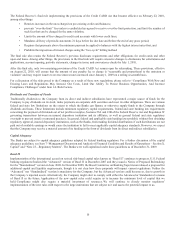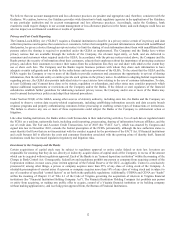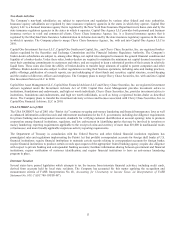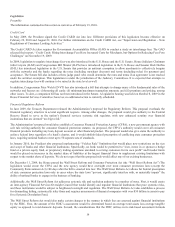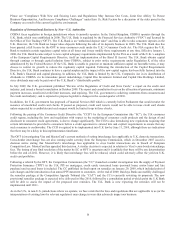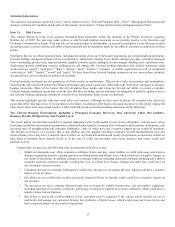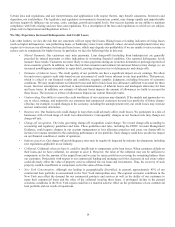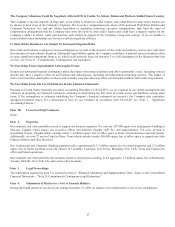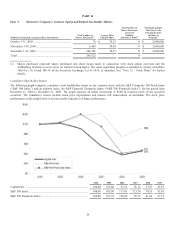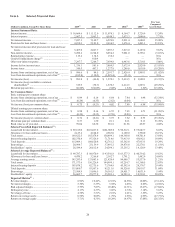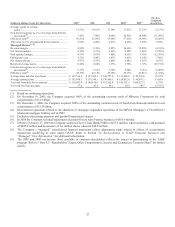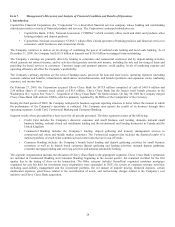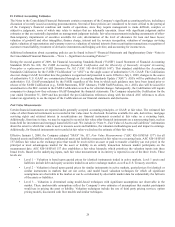Capital One 2009 Annual Report Download - page 33
Download and view the complete annual report
Please find page 33 of the 2009 Capital One annual report below. You can navigate through the pages in the report by either clicking on the pages listed below, or by using the keyword search tool below to find specific information within the annual report. 20
We May Experience Increased Losses Associated with Mortgage Repurchases and Indemnification Obligations
Certain of our subsidiaries, including GreenPoint and CONA, as successor to Chevy Chase Bank, may be required to repurchase
mortgage loans that have been sold to investors in the event there are certain breaches of certain representations and warranties
contained within the sales agreements. We may be required to repurchase mortgage loans that we sell to investors in the event that
there was improper underwriting or fraud, or in the event that the loans become delinquent shortly after they are originated. These
subsidiaries also may be required to indemnify certain purchasers and others against losses they incur in the event of breaches of
representations and warranties and in various other circumstances, and the amount of such losses could exceed the repurchase amount
of the related loans. Consequently, we may be exposed to credit risk associated with sold loans. We have established a reserve in the
consolidated financial statements for potential losses that are considered to be both probable and reasonably estimable related to the
mortgage loans sold by our originating subsidiaries. The adequacy of the reserve and the ultimate amount of losses incurred will
depend on, among other things, the actual future mortgage loan performance, the actual level of future repurchase and indemnification
requests, the actual success rate of claimants, developments in Company and industry litigation, actual recoveries on the collateral, and
macroeconomic conditions (including unemployment levels and housing prices). Due to uncertainties relating to these factors, we
cannot reasonably estimate the total amount of losses that will actually be incurred as a result of our subsidiaries’ repurchase and
indemnification obligations, and there can be no assurance that our reserves will be adequate or that the total amount of losses incurred
will not have a material adverse effect upon the Company’s financial condition or results of operations. For additional information
related to the Company’s mortgage loan operations, mortgage loan repurchase and indemnification obligations and related reserves,
see Item 7 “Management Discussion and Analysis of Financial Conditions and Results of Operations – Valuation of Representation
and Warranty Reserve”.
We may not be able to maintain adequate capital levels, which could have a negative impact on our business results
As a result of recent economic and market developments, financial institutions may become subject to new and increased capital
requirements. While it is not clear what form these requirements might take or whether they will apply to the Company, it is possible
that we could be required to increase our capital buffers more quickly than we can generate additional capital. Thus, such new
requirements could have a negative impact on our ability to lend, to grow deposit balances and/or on our returns.
Among the proposals under consideration:
• Under the Wall Street Reform and Consumer Protection Act as passed by the House in December 2009, financial holding
companies that are deemed to pose systemic risks would be subject to heightened oversight and scrutiny, including
increased risk-based capital requirements and leverage limits under regulations to be promulgated by the Federal Reserve.
The legislation also would require the Federal Reserve to take prompt corrective action with respect to systemically
important firms that do not meet minimum capital requirements and authorizes the Federal Reserve to require systemically
important firms to maintain a minimum amount of long-term hybrid debt that would be convertible to equity under certain
circumstances. No companion bill for to the Wall Street Reform Act has yet been introduced in the Senate.
• In December 2009, the Basel Committee on Banking Supervision released for comment a proposal to strengthen global
capital regulations. The key elements of the proposal include raising the quality, consistency and transparency of the
capital base, strengthening the risk coverage of the capital framework, introducing a leverage ratio that is different from
the U.S. leverage ratio measures and promoting the build-up of capital buffers. The U.S. banking agencies are expected to
issue a similar version of the proposal later this year. Although any U.S. proposal would apply to banking organizations
subject to the Basel II regime to which the Company is not currently subject, the proposal might also impact the Company
and other banking organizations.
• In January 2010, the OCC and the Federal Reserve announced a final rule regarding capital requirements related to the
adoption of ASC 860/SFAS 166 and ASC 810/SFAS 167. Under the final rule, the Company and its subsidiary banks will
be required to hold capital against those risk-weighted assets consolidated as a result of the application of ASC 860/SFAS
166 and ASC 810/SFAS 167.
• We maintain a substantial deferred tax asset on our balance sheet, and we include this asset when calculating our
regulatory capital levels. However, for regulatory capital purposes, deferred tax assets that are dependent on future taxable
income are limited to the lesser of: (i) the amount of deferred tax assets we expect to realize within one year of the
calendar quarter-end date, based on our projected future taxable income for that year; or (ii) 10% of the amount of our
Tier 1 capital. In addition, the Basel Committee’s capital proposal would require a reduction from capital for any deferred
tax assets that are dependent on future earnings. As a result, we may not be able to consider the full value of the deferred
tax asset when calculating our regulatory capital levels.


